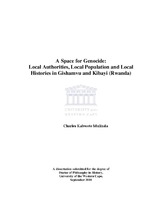| dc.contributor.advisor | Hayes, Patricia | |
| dc.contributor.author | Mulinda, Charles Kabwete | |
| dc.contributor.other | Dept. of History | |
| dc.date.accessioned | 2014-03-28T08:58:03Z | |
| dc.date.available | 2013/03/20 | |
| dc.date.available | 2013/03/20 14:55 | |
| dc.date.available | 2014-03-28T08:58:03Z | |
| dc.date.issued | 2010 | |
| dc.identifier.uri | http://hdl.handle.net/11394/3061 | |
| dc.description | Philosophiae Doctor - PhD | en_US |
| dc.description.abstract | This research attempts to answer the following questions: How and why genocide became possible in Gishamvu and Kibayi? In other words, what was the nature of power at different epochs and how was it exercised? How did forms of political competition evolve? In relation to these forms of competition, what forms of violence occurred acrosshistory and how did they manifest themselves at local level up to 1994? And what was the place of identity politics? Then, what were economic and social conditions since colonial times up to 1994 and how were these conditions instrumentalized in the construction of the ideology of genocide? Finally, how did the Tutsi genocide unfold in Gishamvu and Kibayi? | en_US |
| dc.language.iso | en | en_US |
| dc.publisher | University of the Western Cape | en_US |
| dc.subject | Rwandan genocide | en_US |
| dc.subject | The civil war of 1990 | en_US |
| dc.subject | Hutu power ideology against Tutsi | en_US |
| dc.subject | Economic exploitation | en_US |
| dc.subject | Ecological and economic crisis of the 1980s-1990s | en_US |
| dc.title | A space for genocide: local authorities, local population and local histories in Gishamvu and Kibayi (Rwanda) | en_US |
| dc.rights.holder | Copyright: University of the Western Cape | en_US |
| dc.description.country | South Africa | |

